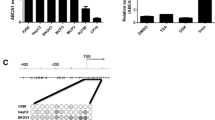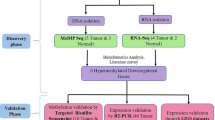Abstract
Silencing of tumor suppressor and tumor-related genes by promoter hypermethylation is one of the major events in ovarian carcinogenesis. In this study, we analyzed aberrant promoter methylation of p16 and RAR-β genes in 134 epithelial ovarian carcinomas (EOCs), 23 low malignant potential (LMP) tumors, 26 benign cystadenomas, and 15 normal ovarian tissues. Methylation was investigated by methylation-specific PCR (MSP), and the results were confirmed by bisulfite DNA sequencing. Relative gene expression of p16 and RAR-β was done using quantitative reverse transcriptase PCR (qRT-PCR) on 51 EOC cases, 9 LMP tumors, and 7 benign cystadenomas with 5 normal ovarian tissues. Aberrant methylation for p16 and RAR-β was present in 43 % (58/134) and 31 % (41/134) in carcinoma cases, 22 % (05/23) and 52 % (12/23) in LMP tumors, and 42 % (11/26) and 69 % (18/26) in benign cystadenomas. No methylation was observed in any of the normal ovarian tissues. The mRNA expression level of p16 and RAR-β was significantly downregulated in EOC and LMP tumors than the corresponding normal tissues whereas the expression level was normal in benign cystadenomas for p16 and slightly reduced for RAR-β. A significant correlation of p16 promoter methylation was observed with reduced gene expression in EOC. For RAR-β, no significant correlation was observed between promoter methylation and gene expression. Our results suggest that epigenetic alterations of p16 and RAR-β have an important role in ovarian carcinogenesis and that mechanism along with methylation plays a significant role in downregulation of RAR-β gene in ovarian cancer.




Similar content being viewed by others
References
Parkin DM, Bray F, Ferlay J, et al. Global cancer statistics, 1998. CA Cancer J Clin. 2005;55:74–108.
Three-year report of population based cancer registries 2009–11: National Cancer Registry Programme (ICMR), Bangalore 2013.
Hennessy BT, Coleman RL, Markman M. Ovarian cancer. Lancet. 2009;374:1371–8.
Wei SH, Balch C, Paik HH, Kim YS, Baldwin RL, Liyanarachchi S, et al. Prognostic DNA methylation biomarkers in ovarian cancer. Clin Cancer Res. 2006;12:2788–94.
Jones PA, Baylin SB. The epigenomics of cancer. Cell. 2007;128:683–92.
Warnecke PM, Bestor TH. Cytosine methylation and human cancer. Curr Opin Oncol. 2000;12:68–73.
Baylin SB, Herman JG. DNA Hypermethylation in tumorigenesis: epigenetics joins genetics. Trends Genet. 2000;16:168–74.
Liggett Jr WH, Sidransky D. Role of the p16 tumor suppressor gene in cancer. J Clin Oncol. 1998;16:197–206.
Kamb A, Gruis NA, Weaver-Feldhaus J, Liu Q, Harshman K, Tavtigian SV, et al. A cell cycle regulator potentially involved in genesis of many tumor types. Science. 1994;264:436–40.
Nobori T, Miura K, Wu DJ, Lois A, Takabayashi K, Carson DA. Deletions of the cyclin-dependent kinase- 4 inhibitor gene in multiple human cancers. Nature. 1994;368:753–6.
Serrano M, Hannon GJ, Beach D. A new regulatory motif in cell-cycle control causing specific inhibition of cyclin D/CDK4. Nature. 1993;366:704–7.
Cobrinik D, Dowdy SF, Hinds PW, Mittnacht S, Weinberg RA. The retinoblastoma protein and the regulation of cell cycling. Trends Biochem Sci. 1992;17:312–5.
Sherr CJ, Roberts JM. Cdk inhibitors: positive and negative regulators of G1-phase progression. Genes Dev. 1999;13:1501–12.
Zhang HS, Postigo AA, Dean DC. Active transcriptional repression by the Rb-E2F complex mediates G1 arrest triggered by p16INK4a, TGFbeta, and contact inhibition. Cell. 1999;97:53–61.
Rocco JW, Sidransky D. p16 (MTS-1/CDKN2/INK4a) in cancer progression. Exp Cell Res. 2001;264:42–55.
Grummer MA, Thet LA, Zachman RD. Expression of retinoic acid receptor genes in fetal and newborn rat lung. Pediatr Pulmonol. 1994;17:234–8.
Mendelsohn C, Lohnes D, Decrimo D, Lufkin T, LeMeur M, Chambon P, et al. Function of the retinoic acid receptors (RARs) during development (II). Multiple abnormalities at various stages of organogenesis in RAR double mutants. Development. 1994;120:2749–71.
Chambon P. A decade of molecular biology of retinoic acid receptors. FASEB J. 1996;10:940–54.
Yang Q, Mori I, Shan L, Nakamura M, Nakamura Y, Utsunomiya H, et al. Biallelic inactivation of retinoic acid receptor 2 gene by epigenetic change in breast cancer. Am J Pathol. 2001;158:299–303.
Ivanova T, Petrenko A, Gritsko T, Vinokourova S, Eshilev E, Kobzeva V, et al. Methylation and silencing of the retinoic acid receptor-beta 2 gene in cervical cancer. BMC Cancer. 2002;2:4 (e1).
Yang Q, Yoshimura G, Mori I, Sakurai T, Kakudo K. Chromosome 3p and breast cancer. J Hum Genet. 2002;47:453–9.
Nakayama T, Watanabe M, Yamanaka M, Hirokawa Y, Suzuki H, Ito H, et al. The role of epigenetic modifications in retinoic acid receptor Beta2 gene expression in human prostate cancers. Lab Investig. 2001;81:1049–57.
Fackler MJ, McVeigh M, Evron E, Garrett E, Mehrotra J, Polyak K, et al. DNA methylation of RASSF1A, HIN-1, RAR-beta, Cyclin D2 and twist in in situ and invasive lobular breast carcinoma. Int J Cancer. 2003;107:970–5.
Jerónimo C, Henrique R, Hoque MO, Ribeiro FR, Oliveira J, Fonseca D, et al. Quantitative RARbeta2 hypermethylation: a promising prostate cancer marker. Clin Cancer Res. 2004;10:4010–4.
Fischer JR, Ohnmacht U, Rieger N, Zemaitis M, Stoffregen C, Kostrzewa M, et al. Promoter methylation of RASSF1A, RARbeta and DAPK predict poor prognosis of patients with malignant mesothelioma. Lung Cancer. 2006;54:109–16.
He M, Vanaja DK, Karnes RJ, Young CY. Epigenetic regulation of Myc on retinoic acid receptor beta and PDLIM4 in RWPE1 cells. Prostate. 2009;69:1643–50.
Björklund P, Akerström G, Westin G. Accumulation of nonphosphorylated beta-catenin and c-myc in primary and uremic secondary hyperparathyroid tumors. J Clin Endocrinol Metab. 2007;92:338–44.
Bhagat R, Shilpa V, Premalata CS, Ramesh G, Ramesh C, Pallavi VR, et al. Aberrant promoter methylation of the RASSF1A and APC genes in epithelial ovarian carcinoma development. Cell Oncol. 2012;35:473–9.
Herman JG, Graff JR, Myohanen S, Nelkin BD, Baylin SB. Methylation specific PCR: a novel PCR assay for methylation status of CpG islands. Proc Natl Acad Sci U S A. 1996;93:9821–6.
Ogino S, Kawasaki T, Brahmandam M, Cantor M, Kirkner GJ, Spiegelman D, et al. Precision and performance characteristics of bisulfite conversion and real-time PCR (MethyLight) for quantitative DNA methylation analysis. J Mol Diagn. 2006;8:209–17.
Parrish RR, Day JJ, Lubin FD. Direct bisulfite sequencing for examination of DNA methylation with gene and nucleotide resolution from brain tissues. Curr Protoc Neurosci. 2012 July; CHAPTER: Unit 7.24. doi:10.1002/0471142301.ns0724s60.
Herman JG, Baylin SB. Gene silencing in cancer in association with promoter hypermethylation. New Engl J Med. 2003;349:2042–54.
Milde-Langosch K, Ocon E, Becker G, Loning T. p16/MTS1 inactivation in ovarian carcinomas: high frequency of reduced protein expression associated with hypermethylation or mutation in endometrioid and mucinous tumors. Int J Cancer. 1998;79:61–5.
McCluskey LL, Chen C, Delgadillo E, Felix JC, Muderspach LI, Debeau L. Differences in p16 gene methylation and expression in benign and malignant ovarian tumors. Gynecol Oncol. 1999;72:87–92.
Wong YF, Chung TK, Cheung TH, Nobori T, Yu AL, Yu J, et al. Methylation of p16INK4A in primary gynecologic malignancy. Cancer Lett. 1999;136:231–5.
Furlan D, Carnevali I, Marcomini B, Cerutti R, Dainese E, Capella C, et al. The high frequency of de novo promoter methylation in synchronous primary endometrial and ovarian carcinomas. Clin Cancer Res. 2006;12:3329–36.
Li M, Huang ZJ, Dong WH, Li XY, Wang XY, He XH, et al. Disfigurement of p16INK4A gene expression in development of ovarian cancer and the mechanism. Zhonghua Fu Chan Ke Za Zhi. 2006;41:408–12.
Wiley A, Katsaros D, Chen H, Rigault de la Longrais IA, Beeghly A, Puopolo M, et al. Aberrant promoter methylation of multiple genes in malignant ovarian tumors and in ovarian tumors with low malignant potential. Cancer. 2006;107:299–308.
Leal Rojas P, Anabalón Rodríguez L, García Muñoz P, Tapia Escalona O, Guzmán González P, Araya Orostica JC, et al. Promoter hypermethylation gene patterns in gynecological tumors. Med Clin (Barc). 2009;132:371–6.
Makarla PB, Saboorian MH, Ashfaq R, Toyooka KO, Toyooka S, Minna JD, et al. Promoter hypermethylation profile of ovarian epithelial neoplasms. Clin Cancer Res. 2005;11:5365–9.
Bammidi LS, Neerukonda GN, Murthy S, Kanapuram RD. p16 gene alterations in human ovarian cancer: comparison between tissue and blood samples. Int J Gynecol Cancer. 2012;22(4):553–60.
Widschwendter M, Berger J, Hermann M, Müller HM, Amberger A, Zeschnigk M, et al. Methylation and silencing of retinoic acid receptor-beta 2 gene in breast cancer. J Natl Cancer Inst. 2000;92(10):826–32.
Gao YP, Li M, Zhang YY, Wang H, He XH, Wang ZH. Relationship between RAR-beta gene expression defect and its methylation. Zhonghua Fu Chan Ke Za Zhi. 2007;42(7):472–6.
Tang D, Kryvenko ON, Mitrache N, Do KC, Jankowski M, Chitale DA, et al. Methylation of RAR-β gene increases prostate cancer risk in black Americans. J Urol. 2013;190(1):317–24.
Chmelarova M, Krepinska E, Spacek J, Laco J, Nekvindova J, Palicka V. Methylation analysis of tumour suppressor genes in ovarian cancer using MS-MLPA. Folia Biol (Praha). 2012;58:246–50.
Ozdemir F, Altinisik J, Karateke A, Coksuer H, Buyru N. Methylation of tumor suppressor genes in ovarian cancer. Exp Ther Med. 2012;4(6):1092–6.
Khodyrev DS, Loginov VI, Pronina IV, Kazubskaya TP, Garkavtsera RF, Braga EA. Methylation of promoter region of RAR-β2 gene in renal cell, breast and ovarian carcinomas. Russ J Genet. 2008;44(8):983–8.
Katsaros D, Cho W, Singal R, Fracchioli S, Rigault De La Longrais IA, Arisio R, et al. Methylation of tumor suppressor gene p16 and prognosis of epithelial ovarian cancer. Gynecol Oncol. 2004;94:685–92.
Leu YW, Rahmatpanah F, Shi H, Wei SH, Liu JC, Yan PS, et al. Double RNA interference of DNMT3b and DNMT1 enhances DNA demethylation and gene reactivation. Cancer Res. 2003;63:6110–5.
Marchini S, Codegoni AM, Bonazzi C, Chiari S, Broggini M. Absence of deletions but frequent loss of expression of p16INK4 in human ovarian tumours. Br J Cancer. 1997;76:146–9.
Fujita M, Enomoto T, Haba T, Nakashima R, Sasaki M, Yoshino K, et al. Alteration of p16 and p15 genes in common epithelial ovarian tumors. Int J Cancer. 1997;74:148–55.
Niederacher D, Yan HY, An HX, Bender HG, Beckmann MW. CDKN2A gene inactivation in epithelial sporadic ovarian cancer. Br J Cancer. 1999;80:1920–6.
Kaiser PC, Körner M, Kappeler A, Aebi S. Retinoid receptors in ovarian cancer: expression and prognosis. Ann Oncol. 2005;16(9):1477–87.
Acknowledgments
The research work is supported by Department of Biotechnology, India, Grant No BT/PR 13440/MED/30/267/2009. We are grateful to Dr V Shanmugam (Research Assistant, NIMHANS) for helping with the statistical analysis.
Conflict of interest
None.
Ethical clearance
The study was approved by Institutional Ethics Committee and all samples were collected after obtaining written, informed consent from patients.
Author information
Authors and Affiliations
Corresponding author
Electronic supplementary material
Below is the link to the electronic supplementary material.
Supplementary Table S1
(DOCX 13 kb)
Supplementary Table S2
(DOCX 11 kb)
Rights and permissions
About this article
Cite this article
Bhagat, R., Kumar, S.S., Vaderhobli, S. et al. Epigenetic alteration of p16 and retinoic acid receptor beta genes in the development of epithelial ovarian carcinoma. Tumor Biol. 35, 9069–9078 (2014). https://doi.org/10.1007/s13277-014-2136-1
Received:
Accepted:
Published:
Issue Date:
DOI: https://doi.org/10.1007/s13277-014-2136-1




